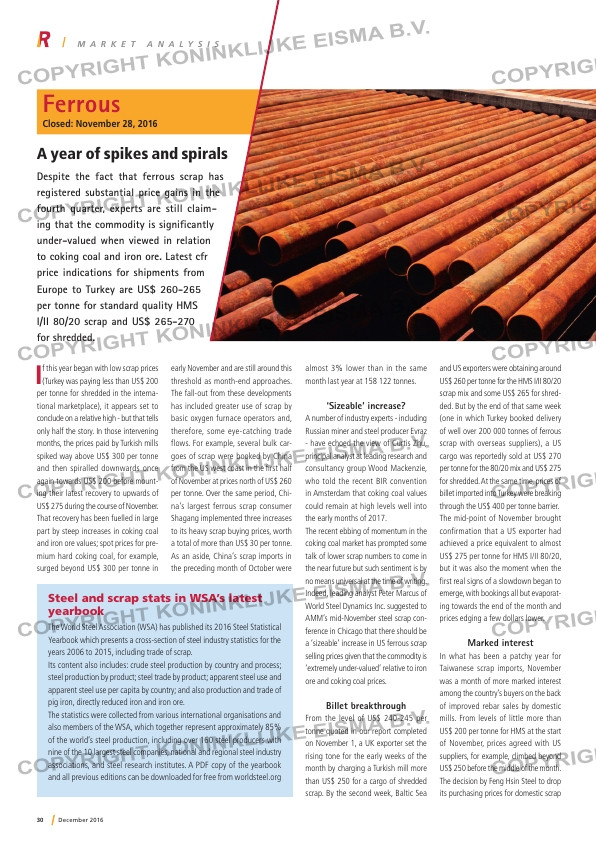Page 30 from: December 2016

30 December 2016
M A R K E T A N A L Y S I S
Ferrous
Closed: November 28, 2016
A year of spikes and spirals
Despite the fact that ferrous scrap has
registered substantial price gains in the
fourth quarter, experts are still claim-
ing that the commodity is significantly
under-valued when viewed in relation
to coking coal and iron ore. Latest cfr
price indications for shipments from
Europe to Turkey are US$ 260-265
per tonne for standard quality HMS
I/II 80/20 scrap and US$ 265-270
for shredded.
If this year began with low scrap prices (Turkey was paying less than US$ 200
per tonne for shredded in the interna-
tional marketplace), it appears set to
conclude on a relative high – but that tells
only half the story. In those intervening
months, the prices paid by Turkish mills
spiked way above US$ 300 per tonne
and then spiralled downwards once
again towards US$ 200 before mount-
ing their latest recovery to upwards of
US$ 275 during the course of November.
That recovery has been fuelled in large
part by steep increases in coking coal
and iron ore values; spot prices for pre-
mium hard coking coal, for example,
surged beyond US$ 300 per tonne in
early November and are still around this
threshold as month-end approaches.
The fall-out from these developments
has included greater use of scrap by
basic oxygen furnace operators and,
therefore, some eye-catching trade
flows. For example, several bulk car-
goes of scrap were booked by China
from the US west coast in the first half
of November at prices north of US$ 260
per tonne. Over the same period, Chi-
na’s largest ferrous scrap consumer
Shagang implemented three increases
to its heavy scrap buying prices, worth
a total of more than US$ 30 per tonne.
As an aside, China’s scrap imports in
the preceding month of October were
almost 3% lower than in the same
month last year at 158 122 tonnes.
‘Sizeable’ increase?
A number of industry experts – including
Russian miner and steel producer Evraz
– have echoed the view of Curtis Zhu,
principal analyst at leading research and
consultancy group Wood Mackenzie,
who told the recent BIR convention
in Amsterdam that coking coal values
could remain at high levels well into
the early months of 2017.
The recent ebbing of momentum in the
coking coal market has prompted some
talk of lower scrap numbers to come in
the near future but such sentiment is by
no means universal at the time of writing.
Indeed, leading analyst Peter Marcus of
World Steel Dynamics Inc. suggested to
AMM’s mid-November steel scrap con-
ference in Chicago that there should be
a ‘sizeable’ increase in US ferrous scrap
selling prices given that the commodity is
‘extremely under-valued’ relative to iron
ore and coking coal prices.
Billet breakthrough
From the level of US$ 240-245 per
tonne quoted in our report completed
on November 1, a UK exporter set the
rising tone for the early weeks of the
month by charging a Turkish mill more
than US$ 250 for a cargo of shredded
scrap. By the second week, Baltic Sea
and US exporters were obtaining around
US$ 260 per tonne for the HMS I/II 80/20
scrap mix and some US$ 265 for shred-
ded. But by the end of that same week
(one in which Turkey booked delivery
of well over 200 000 tonnes of ferrous
scrap with overseas suppliers), a US
cargo was reportedly sold at US$ 270
per tonne for the 80/20 mix and US$ 275
for shredded. At the same time, prices of
billet imported into Turkey were breaking
through the US$ 400 per tonne barrier.
The mid-point of November brought
confirmation that a US exporter had
achieved a price equivalent to almost
US$ 275 per tonne for HMS I/II 80/20,
but it was also the moment when the
first real signs of a slowdown began to
emerge, with bookings all but evaporat-
ing towards the end of the month and
prices edging a few dollars lower.
Marked interest
In what has been a patchy year for
Taiwanese scrap imports, November
was a month of more marked interest
among the country’s buyers on the back
of improved rebar sales by domestic
mills. From levels of little more than
US$ 200 per tonne for HMS at the start
of November, prices agreed with US
suppliers, for example, climbed beyond
US$ 250 before the middle of the month.
The decision by Feng Hsin Steel to drop
its purchasing prices for domestic scrap
Steel and scrap stats in WSA’s latest
yearbook
The World Steel Association (WSA) has published its 2016 Steel Statistical
Yearbook which presents a cross-section of steel industry statistics for the
years 2006 to 2015, including trade of scrap.
Its content also includes: crude steel production by country and process;
steel production by product; steel trade by product; apparent steel use and
apparent steel use per capita by country; and also production and trade of
pig iron, directly reduced iron and iron ore.
The statistics were collected from various international organisations and
also members of the WSA, which together represent approximately 85%
of the world’s steel production, including over 160 steel producers with
nine of the 10 largest steel companies, national and regional steel industry
associations, and steel research institutes. A PDF copy of the yearbook
and all previous editions can be downloaded for free from worldsteel.org



